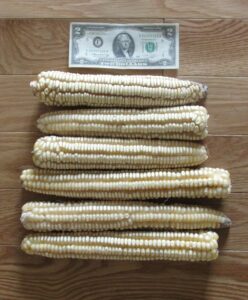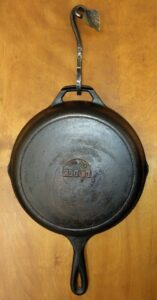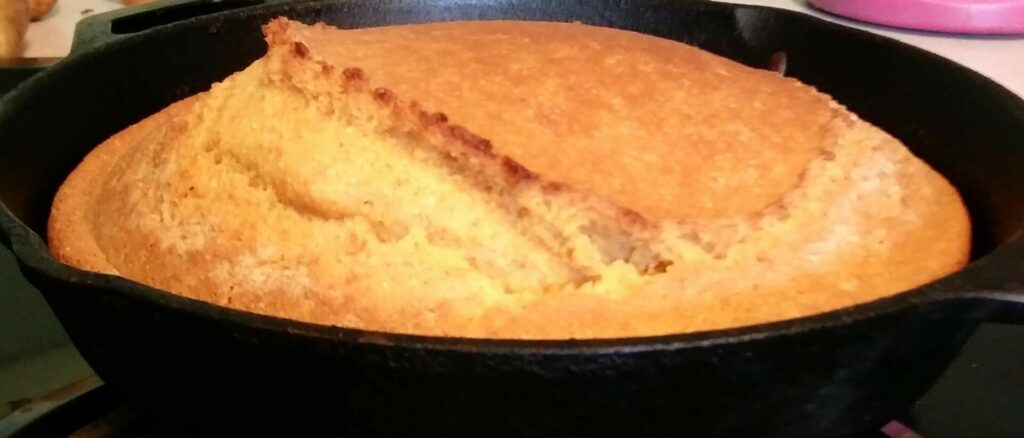Johnson County, TN. At all hours of the day and night in the Mannon house, you’ll find butter in its designated dish on the dinner table and cornmeal in the fridge. I hold strong beliefs about these two points of culinary geography.
I. Room-Temperature Butter
If the promoters of plant-based butter wish to win converts, they should lead with the fact that their emulsion is easily spreadable straight out of the refrigerator. Many a biscuit has been bludgeoned—nearly to death—by cold, hard butter. And if you wait for the heat of the biscuit (or toast) to melt the pat, you get great depth of butter in one spot and too little along the margins. Efforts to work around this dilemma lead to the discovery that butter knives are beveled along one edge only: trying to precisely slice a series of cold-butter slivers will likely lead to the “knife” running out of the edge of the butter.
I choose not to begin my day with such (admittedly first-world) frustrations, and so our butter lives on the table.
The true strength of our butter-on-the-table conviction grows out of our predilection for cornbread. After hearing Jim Minick narrate how his efforts to eat from home lead to cornbread for breakfast, I adopted the practice (see note below). Because cold butter poses an even greater threat to a properly porous (and therefore crumbly) cornbread, and because the Mannon cornbread is special in its own right, I will not abide cold butter.
II. Cold Cornmeal
The recipe we prefer for our cornbread is not complicated or difficult, and it does not require great precision. (Though my range was once broader, today cornbread is the only food my wife still encourages me to bake). A little more or less of any one ingredient doesn’t significantly alter the outcome. And unlike more finnicky breads, cornbread cannot be under proofed or over mixed.
What does matter and what, I think, makes a difference is the cornmeal that comes out of our fridge and the pan that receives the batter.
The latter is a #8 cast iron from Lodge Logic. Ours is, by now, well-seasoned. It goes into the oven while I mix the batter and it warms while the oven preheats. A couple of minutes before the batter goes into the pan, the pan comes out and receives (you guessed it) a pat of butter. The pan and butter go back into the oven. The batter can go in when the butter has completely melted—some bubbling or a little browning now is better than an under-heated skillet. I swirl the butter in the pan until the entire bottom and the shoulder between the bottom and sides are well coated. A hot, well-buttered cast iron skillet is the key to a good bottom crust on cornbread, which is the key to a cornbread that doesn’t stick to the pan; don’t rush this part or skimp on the butter or settle for inferior tools.
Most cornmeal doesn’t need to live in the refrigerator. While the temperature of butter impacts its performance, the coldness of my cornmeal is not the point. My cornmeal lives the fridge because it must.
For each of the last three summers I’ve grown enough bread corn to keep me in cornbread and grits. While an ear of corn is very stable, once the kernels are ground the meal becomes volatile due to the oils in the germ. Unrefrigerated cornmeal of this kind will turn rancid and spoil. Much of the cornmeal in the grocery store was degerminated (what a word!) before being ground; the absence of the germ makes cornmeal from degerminated corn much more shelf stable.
But there is a tradeoff: cornmeal made from degerminated corn is less nutritious, which is part of the reason this product is often “enriched.” Such nutritional “enrichment” always come at some expense. In Selu: Seeking the Corn Mother’s Wisdom, Cherokee writer Marilou Awiakta argues that there are nutritional and spiritual costs to consuming corn that is, literally, unwholesome.
There is more at stake for me, too, than just the nutritional difference. The growing, grinding, and eating of heirloom corn is part of my heritage and has been part of my education. These layers of associations foster an intimacy between my cornbread and me.
I have invested more labor in my cornbread than makes sense to most people. Here’s a story that provides some proof. After more than a year of watching for a good opportunity, my wife and I moved. High on my list of priorities for our new home was more space for a garden. We have it now, which means that my 2021 and 2022 gardens included significant corn patches.

One visitor noticed the corn. He asked what variety it was and then wondered out loud why I would grow bread corn rather than sweet corn. He managed to set the parameters of the discussion—around the cheapness of cornmeal compared to the expense of fresh sweet corn—and I struggled to offer a rational explanation for the time I was spending growing a “low-yielding” feed corn that I wouldn’t eat until it was hard and dry—seemingly inert. I did not volunteer the fact that I had been “wasting” even more labor by hand-grinding my corn in a grain mill and then sifting out the grits from the cornmeal—practices I have continued this year.
I think intermittently–and slowly. And so, predictably, I have returned in thought to that conversation at various times while harvesting, shelling, grinding, and sifting my last two corn harvests. I still do not have a convincing defense of my corn patch on financial grounds. But my corn didn’t grow out of financial ground, and so I’ve given up the pursuit of such calculations. I do know that I feel well paid for the time I’ve spent on corn. And I know the thinking that I have adopted: Awiakta’s and Minick’s, certainly, but also that of Kristin Kimball and Wendell Berry.
More than thirty years ago Wendell Berry stressed that eating could be an “extensive” pleasure. In one of his best-known essays, Berry wrote, “People who know the garden in which their vegetables have grown and know that the garden is healthy will remember the beauty of the growing plants, perhaps in the dewy first light of morning when gardens are at their best. Such a memory involves itself with the food and is one of the pleasures of eating.”
Bread corn can provide a rigorous test of Berry’s claims. My 2021 crop grew dangerously tall; before the prop roots were well-established, successive thunderstorms battered the stalks, leveling some and leaving many others far from plumb. This tangle of stalks was not a pleasure to harvest: some had broken and therefore couldn’t nourish their ears while other ears had been too shaded and they molded before they dried. Memories of these disappointments and frustrations mix with the milk and eggs in my batter. Even so, my cornbread does bring more than enough pleasure. Somewhat paradoxically, some portion of that pleasure comes from the knowledge that my labor and a small measure of determination transformed a lawn that said “grass” into a garden that grunted “corn.” In other words, some of the pleasure I take from my cornbread comes from the knowledge that it can’t be found by taking the path of least resistance.
Toward the end of Kristin Kimball’s The Dirty Life, she feels compelled to sum up what she has learned after leaving her work as a travel writer and turning to the more difficult life of a farmer. She says, “Here’s the best I can do: a bowl of beans, rest for tired bones.” She suggests that “these things are reasonable roots for a life” that are “so much the better” if “you can tire your own bones while growing the beans.” There is an elegance in feeding a hungry body with calories that body helped create.

There are also non-literary explanations for the Mannon cornbread: bread corn is something of a family tradition.
My maternal grandfather was “retired” for all the years that I knew him. As I’ve written before, his retirement was characterized by labor that yielded things integral to life, especially food. As an adolescent and teen, I perfected my sweet-corn-eating technique on ears (probably hundreds) from his gardens.
I was less impressed, in those years, by the Hickory King that he grew and then rendered into hominy or ground into cornmeal. I was too careless and too in-a-hurry to recognize the significance of these foods to him. He told one story often. On trips home during the semester he spent in college, he would regularly crave the same meal: a tall glass of milk poured over crumbled cornbread. He made many a supper out of the same ingredients in his later years, and introduced me to the “recipe.” And because my mother curated his strain of Hickory King corn, I can re-incarnate that meal and revitalize those memories today. In so doing, I am taking my turn at preserving one piece of my family’s heritage and one strain of old corn. And so I keep my cornmeal safe and cold.
NB: At an Appalachian Studies Association Conference, I heard Jim Minick deliver a version of “How to Make Cornbread, or Thoughts on Being an Appalachian from Pennsylvania Who Calls Virginia Home but Now Lives in Georgia”—now available in Appalachian Reckoning: A Region Responds to Hillbilly Elegy.
Images by Author.















Like an opened bottle of wine, I’m not sure any cornmeal has lingered long enough to go rancid. However, if you are grinding your own (applause for that one) I can understand one not wanting to run that risk. Our household also follows the butter out-at-all-times rule (see first sentence for an additional reason). And, Ethan, I was prepared to throw down, being in a disputatious mood always, on the lack of mention regarding the proper color of cornmeal. But since you shared a picture of your white Hickory King, I assume you felt that there was no need. Since all proper Southerners know cornbread is made with white cornmeal.
Good stuff. I’m reminded of some favorite lines from Death Comes for the Archbishop, about an onion soup prepared by Catholic missionaries from France during a lonely Christmas Day on the frontier in 19th century New Mexico: “A soup like this is not the work of one man. It is the result of a constantly refined tradition. There are nearly a thousand years of history in this soup.”
Such a wonderful story. I hope you never again feel the need to justify your own labor to someone who thinks machine made products are as good as anything you make yourself! Think of the tactile pleasure they are missing out on, and the almost religious pleasure of watching corn grow, as we did as kids. Well, I guess you can’t explain much to people like that. A friend was watching me spin yarn once out of a lovely sheep’s fleece, and she said “You know you can just buy yarn.” I, too was gobsmacked and had no idea how to answer. I ended mumbling something about liking to spin and left it at that. You just can’t explain some things to some people. And I always leave my butter out, too. What would I put on freshly baked bread?
It might be helpful (and ungobsmacking) to consider that “you can just buy it” isn’t necessarily disdain or laziness. It might be what an old friend of mine described as “they don’t want to miss the train” — a sense of personal time being too tightly organized to consider alternatives to one’s routine.
Great reflections, Ethan.
I think fake butter and overt margarine already advertise spreadability.
I recall seeing a movie decades ago that was set in UK, early 20th century I think. I was struck by the fact that the family left not only butter but also meat and cheese on the table round the clock. I suppose an ambient temperature of 50 F (10 C nowadays, and landlords there can be fined if they don’t maintain that minimum continuously for tenants) made spoilage much slower.
Here in the tropics, we take the butter out of the fridge and it’s ready to spread in about 10 minutes, just when the coffee has finished brewing in the French press. Most of the corn sold in Indonesia seems to be feed corn (it certainly isn’t sweet), so maybe I’ll try making cornbread sometime.
Thanks, Ethan, for this eloquent tribute to soft butter, real cornmeal and family history!
Comments are closed.